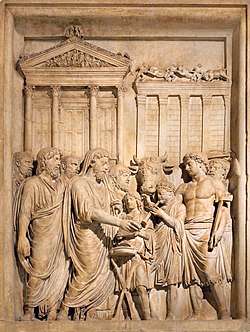Bubona
In ancient Roman religion, Bubona is thought to have been a goddess of cattle, but she is named only by Saint Augustine.
| Religion in ancient Rome |
|---|
 |
| Practices and beliefs |
| Priesthoods |
| Deities |
Deified emperors: |
| Related topics |
Augustine mocks Bubona as one of the minor Roman deities whose names correspond to their functions,[1] and derives her name from the Latin word bos (genitive bovis,[2] hence English "bovine"), which usually means "ox" in the singular and "cattle" in the plural (bubus in the dative and ablative plural; compare bubulcus, one who drives or tends cattle). The formation of this theonym has been compared to that of Bellona, "she who presides over war (bellum)"; Pomona, "she who presides over orchard fruits (pomum)";[3] and Epona, the Romano-Celtic horse goddess (from Gaulish epos, "horse"[4]) whose image was placed in stables as a tutelary for the animals.[5]
Augustine mentions Bubona in two passages. In addition to the passage on theonyms and divine personifications, he lists her among several other deities who had specialized functions for the Romans, in contrast to the one god of the Jews.[6]
Georg Wissowa thought[7] that a festival of cattle (ludi boum causa) mentioned by Pliny must have been dedicated to Bubona.[8] Those who celebrated the rites were called Bubetii, a title which appears only in Pliny.
Classical tradition
In the 18th century, formal gardens often featured sculptures of classical divinities, which were to be selected for the deity's suitability to the function of the area: Silvanus for a grove, for example, or Pomona for an orchard. Bubona was among those recommended for "small paddocks of sheep."[9]
References
- Augustine of Hippo, De civitate Dei 4.24, listing also Bellona, Cunina, Segetia, and Pomona. On Augustine's attitude toward his subject, see Arnaldo Momigliano, "The Theological Efforts of the Roman Upper Classes in the First Century B.C.," Classical Philology 79 (1984), p. 204, among others.
- Giovan Battista Pellegrini, Toponomastica italiana (Hoepli, 1990), p. 64.
- Hendrik Wagenvoort, "Diva Angerona," in Pietas: Selected Studies in Roman Religion (Brill, 1980), p. 22.
- Xavier Delamarre, Dictionnaire de la langue gauloise (Éditions Errance, 2003), pp. 163–164.
- In the 1840s, Leonhard Schmitz asserted that images of Bubona were also placed in stables, but all the passages he cites that describe the practice name only Epona; see Dictionary of Greek and Roman Biography and Mythology (London, 1849), vol. 1, p. 515 online; this appears in other editions as well. See also Ludwig Preller, Römische Mythologie (Berlin, 1858), pp. 594–595, and Hermann Usener, Götternamen: Versuch einer Lehre von der Religiösen Begriffsbildung (Frankfurt, 1896), p. 77–78.
- Augustine, De civitate Dei 4.34; Maijastina Kahlos, Debate and Dialogue: Christian and Pagan Cultures c. 360–430 (Ashgate, 2007), p. 139.
- Georg Wissowa, Religion und Kultus der Römer (Munich, 1902), p. 165.
- Ludos boum causa celebrantes Bubetios vocabant: Pliny, Natural History 18.3.12.
- Batty Langley, New Principles of Gardening (1726), as cited by Mark Leone, "Interpreting Ideology in Historical Archaeology: The William Paca Garden in Annapolis, Maryland," in Ideology, Power, and Prehistory (Cambridge University Press, 1984), p. 28; John Dixon Hunt and Peter Willis, The Genius of the Place: The English Landscape Garden, 1620–1820 (MIT Press, 1988, 2000), p. 185.